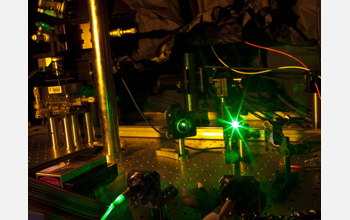Multimedia Gallery
Optical table in the lab of Marko Loncar
The optical table in the lab of Marko Loncar of Harvard University School of Engineering and Applied Sciences who's research group managed to control the rate of emission of photons from diamond nanoposts, an important advance toward quantum computing.
More about this image
Building on earlier work, Loncar, an electrical engineer at the Laboratory for Nanoscale Optics at Harvard, along with his postdoctoral researcher and his students, developed a manufacturing process that allows them to create an assortment of miniature, silver-plated diamond posts that enable greater control of light-producing photons at the atomic scale. The research could be important for future generations of quantum computers.
Prior research demonstrated how nanowires carved in impurity-laden diamond crystal could efficiently emit individual photons, an important discovery for using light to rapidly read and write quantum-based data. But this recent research shows that novel nanostructures--silver-plated diamond posts--can also control the speed at which the process emits individual photons. The development supports efforts to create robust, room temperature quantum computers by setting the stage for diamond-based microchips. Additionally, the technology could support new tools capable of measuring magnetic fields at the nanometer scale. [Note: The microdiamond powder used in this research was provided by Daniel Twitchen and the Element Six Company in the UK.]
To learn more, see the NSF Press Release Diamonds, Silver and the Quest for Single Photons. [Research supported by National Science Foundation grant ECCS 0708905.] (Date of Image: October 2011)
Credit: Eliza Grinnell, Harvard SEAS
Images and other media in the National Science Foundation Multimedia Gallery are available for use in print and electronic material by NSF employees, members of the media, university staff, teachers and the general public. All media in the gallery are intended for personal, educational and nonprofit/non-commercial use only.
Images credited to the National Science Foundation, a federal agency, are in the public domain. The images were created by employees of the United States Government as part of their official duties or prepared by contractors as "works for hire" for NSF. You may freely use NSF-credited images and, at your discretion, credit NSF with a "Courtesy: National Science Foundation" notation.
Additional information about general usage can be found in Conditions.
Also Available:
Download the high-resolution JPG version of the image. (739 KB)
Use your mouse to right-click (Mac users may need to Ctrl-click) the link above and choose the option that will save the file or target to your computer.

